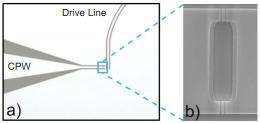a) Optical micrograph of the device. Light parts are Al while dark parts are the Si substrate. The output line is labeled "CPW" and the drive line enters from the top. Both lines converge near the SQUID. b) A scanning-electron micrograph of the SQUID. Image credit: arXiv:1105.4714v1
(PhysOrg.com) -- A group of physicists working out of Chalmers University of Technology in Gothenburg, Sweden, have succeeded in proving what was until now, just theory; and that is, that visible photons could be produced from the virtual particles that have been thought to exist in a quantum vacuum. In a paper published on arXiv, the team describes how they used a specially created circuit called a superconducting quantum interference device (SQUID) to modulate a bit of wire length at a roughly five percent of the speed of light, to produce visible "sparks" from the nothingness of a vacuum.
The experiment shows that the Casimir effect is not just theory; named after Dutch physicist Hendrik B. G. Casimir who along with Dirk Polderfirst first proposed back in the late 1940’s, the idea of a force that existed in a vacuum; a force that should, if manipulated just right between two plates, or mirrors, result in the creation of photons.
The thinking goes that in any vacuum, virtual particles come into existence and then disappear on a constant ongoing basis; and they do so in waves. The Casimir effect proposes that if two very tiny mirrors were to be placed very close together; close enough that the distance between them would be smaller than the length of some of the virtual waves, a force would be created as the number of particles outside of the space between the mirrors grows higher than the number that exists between them, causing a pull on the mirrors, dragging them closer together. The force that is created, it has been theorized, could then be used to generate photons.
Later researchers proposed that the same effect could be achieved using just one mirror if it were moved back and forth very quickly; and that’s the approach the team took in the experiment. The quick movement of the mirror serves to separate pairs of virtual particles which then provide the energy to convert the virtual particles into real photons, which is what happened in the SQUID, allowing the team to see the photons that were produced.
Such research, while theoretically satisfying, doesn’t really offer much in the way of practical applications, at least not at this time; but that’s not to say that new developments that arise as a result of this research couldn’t conceivably lead to something more profound, such as a means of harnessing energy from the vacuum of space to be used to push a vehicle as it travels throughout the universe.
More information: Observation of the Dynamical Casimir Effect in a Superconducting Circuit, arXiv:1105.4714v1 [quant-ph]
Abstract
One of the most surprising predictions of modern quantum theory is that the vacuum of space is not empty. In fact, quantum theory predicts that it teems with virtual particles flitting in and out of existence. While initially a curiosity, it was quickly realized that these vacuum fluctuations had measurable consequences, for instance producing the Lamb shift of atomic spectra and modifying the magnetic moment for the electron. This type of renormalization due to vacuum fluctuations is now central to our understanding of nature. However, these effects provide indirect evidence for the existence of vacuum fluctuations. From early on, it was discussed if it might instead be possible to more directly observe the virtual particles that compose the quantum vacuum. 40 years ago, Moore suggested that a mirror undergoing relativistic motion could convert virtual photons into directly observable real photons. This effect was later named the dynamical Casimir effect (DCE). Using a superconducting circuit, we have observed the DCE for the first time. The circuit consists of a coplanar transmission line with an electrical length that can be changed at a few percent of the speed of light. The length is changed by modulating the inductance of a superconducting quantum interference device (SQUID) at high frequencies (~11 GHz). In addition to observing the creation of real photons, we observe two-mode squeezing of the emitted radiation, which is a signature of the quantum character of the generation process.
© 2010 PhysOrg.com




















